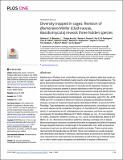Por favor, use este identificador para citar o enlazar a este item:
http://hdl.handle.net/10261/230324COMPARTIR / EXPORTAR:
 SHARE SHARE
 CORE
BASE CORE
BASE
|
|
| Visualizar otros formatos: MARC | Dublin Core | RDF | ORE | MODS | METS | DIDL | DATACITE | |

| Título: | Diversity trapped in cages: Revision of Blumenavia Möller (Clathraceae, Basidiomycota) reveals three hidden species |
Autor: | Melanda, G. C. S.; Accioly, T.; Ferreira, Renato Juciano; Rodrigues, A. C. M; Cabral, T.S.; Coelho, G.; Sulzbacher, M.A.; Cortez, Vagner G.; Grebenc, T.; Martín, María P. CSIC ORCID ; Baseia, I.G. | Fecha de publicación: | 2020 | Editor: | Public Library of Science | Citación: | PLoS ONE 15 (2020) | Resumen: | Basidiomata of Phallales have a diversified morphology with adhesive gleba that exudes an odor, usually unpleasant that attracts mainly insects, which disperse the basidiospores. The genus Blumenavia belongs to the family Clathraceae and, based on morphological features, only two species are currently recognized: B. rhacodes and B. angolensis. However, the morphological characters adopted in species delimitations within this genus are inconsistent, and molecular data are scarce. The present study aimed to review and identify informative characters that contribute to the delimitation of Blumenavia species. Exsiccates from America and Africa were analyzed morphologically, and molecularly, using ITS, LSU, ATP6, RPB2 and TEF-1α markers for Maximum Parsimony, Bayesian and Maximum likelihood analyses, and also for coalescent based species delimitations (BP&P), as well as for bPTP, PhyloMap, Topo-phylogenetic and Geophylogenetic reconstructions. According to our studies, seven species can be considered in the genus: B. rhacodes and B. angolensis are maintained, B. usambarensis and B. toribiotalpaensis are reassessed, and three new species are proposed, B. baturitensis Melanda, M.P. Martín & Baseia, sp. nov., B. crucis-hellenicae G. Coelho, Sulzbacher, Grebenc & Cortez, sp. nov., and B. heroica Melanda, Baseia & M.P. Martín, sp. nov. Blumenavia rhacodes is typified by selecting a lectotype and an epitype. Macromorphological characters considered informative to segregate and delimit the species through integrative taxonomy include length of the basidiomata, color, width and presence of grooves on each arm as well as the glebifer position and shape. These must be clearly observed while the basidiomata are still fresh. Since most materials are usually analyzed after dehydration and deposit in collections, field techniques and protocols to describe fugacious characters from fresh specimen are demanded, as well as the use of molecular analysis, in order to better assess recognition and delimitation of species in Blumenavia. | Versión del editor: | http://dx.doi.org/10.1371/journal.pone.0232467 | URI: | http://hdl.handle.net/10261/230324 | DOI: | 10.1371/journal.pone.0232467 | Identificadores: | doi: 10.1371/journal.pone.0232467 issn: 1932-6203 |
| Aparece en las colecciones: | (RJB) Artículos |
Ficheros en este ítem:
| Fichero | Descripción | Tamaño | Formato | |
|---|---|---|---|---|
| pone.0232467.pdf | 6,58 MB | Adobe PDF |  Visualizar/Abrir |
CORE Recommender
Page view(s)
80
checked on 17-abr-2024
Download(s)
60
checked on 17-abr-2024
Google ScholarTM
Check
Altmetric
Altmetric
NOTA: Los ítems de Digital.CSIC están protegidos por copyright, con todos los derechos reservados, a menos que se indique lo contrario.
